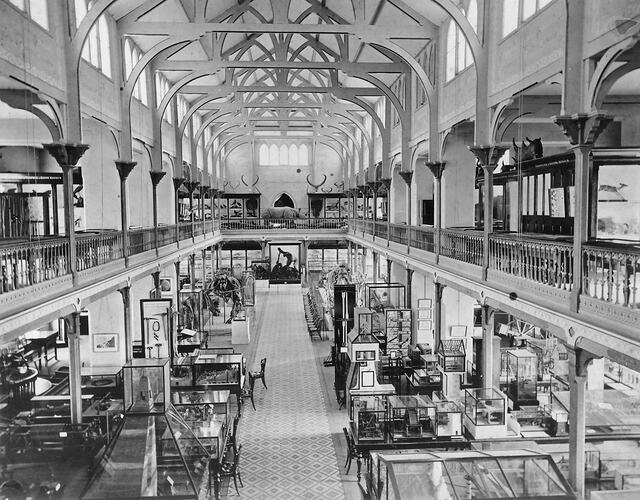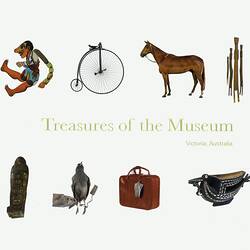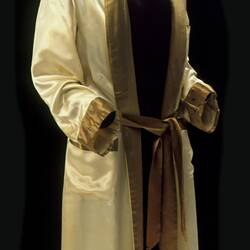In Melbourne 1854, two small rooms were set aside in a government office for the purpose of accommodating specimens 'which may from time to time be forwarded to the intended museum of natural history'. One and a half centuries later, Museums Victoria is a multi-campus, multi-discipline institution, providing exhibitions and research, education and public programs, whilst continuing to care for the states heritage.
1854-1899: Early Days of the Museum
Museums Victoria has its origins in the Museum of Natural History, which opened on 9 March 1854 in the Government Assay Office in La Trobe Street, Melbourne. An independent colony since 1851, Victoria was experiencing a boom brought about by the gold rushes. The local regions of Melbourne and Geelong were occupied by a population of more than 80 000 people and nearly 6 million sheep. As the surrounding countryside was explored, the first collections of new and unusual geological and biological specimens began to take shape. The museum was transferred to more distinguished surroundings at the University of Melbourne in Parkville in 1856 and became formally known as the National Museum of Victoria. In 1858, Professor Frederick McCoy was appointed its director and the collections quickly burgeoned. McCoy sourced material both locally and overseas to help establish the priceless natural history collection at the museum. This led to his encyclopaedic works Prodromus of the Zoology of Victoria and Prodromus of the Palaeontology of Victoria, which were attempts to describe the animal species found in the state. McCoy achieved remarkable coverage of Victoria's living and extinct fauna, and his systematic collection still forms an important basis for the museum's natural history holdings. The National Museum of Victoria continued to benefit from a wealth of local as well as international acquisitions. New items made their way into the collection with the rapid growth of mining and agricultural industries in Victoria during the later half of the 19th century. Another beneficiary of this period was the Industrial and Technological Museum, which had opened in 1870 in the Public Library building in Swanston Street. The collections of the both museums continued to develop in parallel until 1899, when it was decided to relocate the National Museum to the Public Library building also. Melbourne's citizens were presented with the spectacle of wagons loaded with glass cases, stuffed animals and other curiosities as over 510 000 items were carted across town.
1900-1999: 100 Years at Swanston Street
Melbourne's Age newspaper had long promoted the view that the rightful home for the National Museum of Victoria was the Public Library building in Swanston Street. Its relocation there for the start of a new century was greeted enthusiastically. Meanwhile, the Industrial and Technological Museum, which had been housed on the site since 1870, was consigned to the vaults. It would not be revived again until 1915. The National Museum's collections continued to grow steadily, and the institution took to collecting in anthropology as well as the natural sciences. The practices of purchase and donation were soon supplemented by a program of museum expeditions and fieldwork within Victoria and interstate. Professor Walter Baldwin Spencer, director of the National Museum from 1899 to 1928, was primarily a biologist, but also pursued an interest in anthropology. He carried out major expeditions to study Aboriginal communities in Central and northern Australia. Spencer built up a precious collection of Indigenous artefacts for the museum, along with supporting notes and photography, and motion picture and sound recordings. Over the years, important material from the geological, biological and ethnographic collections was exhibited in the various museum galleries, including the grand McCoy Hall. The revived Industrial and Technological Museum continued to grow, and eventually became the Science Museum of Victoria. In 1983, Melbourne's two big museums on the Swanston Street site, the National Museum of Victoria and the Science Museum of Victoria, amalgamated to form the Museum of Victoria (later to become Museum Victoria then Museums Victoria). For the first time, the state's natural history and technology and human history collections were managed in an integrated way, and under the one roof. Several new museum facilities were commissioned and completed during the 1990s. Scienceworks at Spotswood was opened in 1992, featuring the science and technology collections, and the Immigration Museum in Flinders Street opened in 1998. For the museum on Swanston Street, the collections were being packed in readiness for the move to another new home, for the start of another century.
2000 - 2004: Museums Victoria Today
In 2000, the flagship of Museums Victoria opened alongside the Royal Exhibition Building in Carlton Gardens. An award-winning creation, Melbourne Museum is a colourful assemblage of buildings anchored within a 'super-grid' and flanked by enormous raked canopies. It sits in stark contrast to the grand Royal Exhibition Building with its domed Great Hall, designed by Joseph Reed for the 1880-81 Melbourne International Exhibition. The Immigration Museum, at the opposite end of town, is housed in the classical Old Customs House, dating from 1876 and designed by John James Clark. In the west, the Scienceworks complex includes the historic 19th-century Spotswood Pumping Station, the plans of which are attributed to Christian Kussmaul. This distinguished set of buildings comprises significant cultural heritage, which we manage with a similar level of care to that of our collection. Museums Victoria as we know it today has grown to a large and diverse organisation. Historically, it has always had a primary role as the Victorian state museum, collecting the state's natural and cultural heritage. It also continues to develop and manage a collection of national significance. The museum is always looking to acquire new material. The acquisition is not a random process but is guided by a sound collection policy, and expert advice from curators. Sometimes there is an element of luck, and we know straight away that we have obtained a valuable item. At other times, it might take years for the true value of a treasure to become apparent. In yet other areas we are creating new collections, such as a tissue bank representing Australian fauna. With the rapid development of the museum over the last 20 years, there have been major improvements in storage facilities for the collection. Previous perceptions of museums might have been of grimy and dusty specimens, reeking of mothballs and packed to the rafters in dark and musty vaults. This is a far cry from what we see today. Storage facilities are world class, and built to meet strict collection management and conservation standards. Our treasures are cared for both in and out of the public's gaze.
More Information
-
Keywords
social history, European Settlement of Australia, Aboriginal History, Aboriginal People, Aboriginal Issues, immigration, Gold Rushes, Royal Exhibition Building, World War I, 1914-1918, World War II, 1939-1945, Aboriginal peoples (Australians), Economic Depression, 1890s, Migration & Settlement, Migration Schemes, feminism, motor vehicle factories, Royal Visits, Olympic Games: Melbourne, 1956
-
Localities
-
Authors
-
Article types



